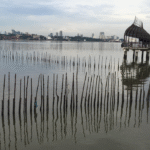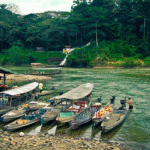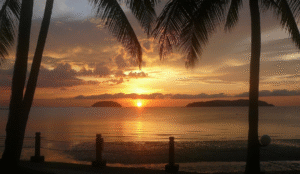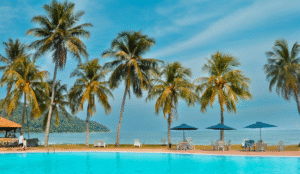Diving in Sipadan: One of the World’s Best Dive Spots
Nestled in the shimmering turquoise waters of the Celebes Sea, off the coast of Sabah in Malaysian Borneo, lies an underwater paradise that has long captivated divers from around the globe-Sipadan. Revered for its untouched beauty and biodiversity, Sipadan is not just another dive site; it’s a place of pilgrimage for those who seek the extraordinary beneath the surface.
Recognized as one of the best dives site, Barracuda Point, Turtle Cavern, and Drop Off Wall are names that stir excitement in the hearts of experienced divers. But what truly makes Sipadan stand out isn’t just the marine life—it’s the sense of untouched wonder that lingers in every dive.
Frequently Asked Questions (FAQ)
1. What is Sipadan diving famous for?
Sipadan diving is world-famous for its crystal-clear waters, rich marine biodiversity, and dramatic underwater scenery. It’s one of the few places on Earth where you can see turtles, sharks, barracudas, and swirling schools of fish all in one dive. The island is surrounded by deep drop-offs and coral walls, making every dive site stunning and full of life.
2. What is the world ranking of Sipadan diving?
Sipadan is often ranked among the top 5 diving destinations in the world by professional divers and dive magazines. It has been called the “crown jewel of Southeast Asian diving”, thanks to its untouched reefs and strict conservation rules that limit daily visitors. Many divers place it alongside iconic spots like the Galápagos and the Great Barrier Reef.
3. What is considered the best scuba diving in the world?
There’s no single “best” dive site for everyone, but top scuba diving destinations often include:
- Sipadan Island (Malaysia) – for big pelagics and pristine reefs
- Raja Ampat (Indonesia) – for coral biodiversity
- The Galápagos Islands (Ecuador) – for large marine animals
- The Red Sea (Egypt) – for colorful reefs and wrecks
- The Great Barrier Reef (Australia) – for size and variety
Sipadan stands out because of its healthy ecosystem, big fish action, and limited crowding, which makes the experience even more special.
4. Which Malaysian island is known for its diving sites?
Sipadan Island is the most famous Malaysian island for diving, but there are other top spots too, including:
- Mabul and Kapalai – near Sipadan, known for macro diving and underwater photography
- Tioman Island – great for beginner divers and reef exploration
- Redang and Perhentian Islands – popular for coral gardens and clear waters
Still, Sipadan remains the crown jewel for serious divers due to its unique marine life and conservation efforts.
5. Is diving in Sipadan expensive?
Diving in Sipadan can be more expensive than other dive spots in Malaysia, mainly because:
- Access is limited to 120 permits per day, making demand high
- Most visitors stay at nearby islands like Mabul or Kapalai, and package costs include accommodation, permits, and boat transfers
However, the quality of the dives, the abundant marine life, and the protected environment make it well worth the price for many divers. Expect to pay RM1,000–RM2,000+ for a multi-day dive package.
A Natural Wonder Born of Coral
What makes this place geologically unique is that it is the only oceanic island in Malaysia, rising 600 meters from the seabed. Unlike many tropical islands formed from volcanic rock, This place is the peak of an ancient coral reef, built up over thousands of years atop an extinct undersea volcano.
This vertical rise means divers encounter sheer drop-offs and walls teeming with sea life just meters from shore. The nutrient-rich currents around the area draw in large pelagic species, making it a prime spot for drift diving with big fish, sharks, and turtles.
Dr. Jacques Cousteau, the legendary oceanographer, once declared, “I have seen other places like Sipadan, 45 years ago, but now no more. Now we have found again an untouched piece of art.” That quote alone cements Sipadan as one of the world’s truly exceptional dive destinations.
Diving Regulations: Protecting a Marine Treasure
Due to its ecological significance, Sipadan is now a protected marine park. Since 2005, the Malaysian government has strictly limited daily visitors to 176 people, ensuring that the reef and its inhabitants remain unspoiled. This system has helped preserve its coral gardens and marine life, but it also means planning is essential.
To dive there, you must apply for a permit (usually through a dive resort or tour operator), and these are granted on a first-come, first-served basis. Only a few operators—based in nearby Mabul or Kapalai—have permission to bring divers to Sipadan, making availability tight, especially during peak seasons (April–October).
Top Dive Sites in Sipadan
Let’s dive into the underwater highlights that make this place a bucket-list destination. While every dive here can feel like a discovery, a few locations stand out for their drama, density of marine life, and sheer underwater beauty.
- Barracuda Point
Arguably the most iconic of the best dives site in Sabah, Barracuda Point lives up to its name with the famous swirling vortex of thousands of chevron barracuda. On a good day, you’ll also encounter reef sharks, turtles, and even bumphead parrotfish.
Drift along the wall while schools of jackfish swarm around you. It’s chaotic, surreal, and absolutely unforgettable. Many divers return to this site multiple times in a single trip—just to chase that one perfect moment with the barracuda tornado.
- South Point
South Point is often where divers go to spot the big stuff. It’s known for pelagic encounters—hammerhead sharks, thresher sharks, and even manta rays have been sighted here. The dive begins with a vertical wall drop before you drift with the current along coral ledges alive with color.
The site’s open, blue-water exposure means anything can swim by, so keep your eyes peeled and your camera ready. No wonder this is often listed among the best dives site for thrill-seekers.
- Turtle Cavern & Turtle Tomb
This haunting yet beautiful dive is a unique feature of this location. Just off the Drop Off Wall lies an entrance to Turtle Cavern—a series of underwater caves and tunnels where many turtles, having entered and lost their way, met their end.
While the idea might seem somber, the cavern is a surreal dive experience. With proper training and guidance, divers can explore the system’s winding chambers and reflect on nature’s silent, majestic power. The play of light inside the cavern is mesmerizing.
- Drop Off Wall
Imagine stepping off the beach and descending into an abyss. That’s the experience at Drop Off Wall, where the reef plunges vertically just a few meters from shore. The wall is adorned with vibrant coral and sponges, and it’s home to everything from nudibranchs to sea turtles.
The sudden drop gives a real sense of scale and awe, and for many, it’s one of the most thrilling and visually striking parts of diving in the location.
Marine Life: A Living Aquarium
What sets Sipadan apart isn’t just the dramatic walls and currents—it’s the sheer concentration of marine biodiversity.
On any given dive, you’re likely to see green and hawksbill turtles—sometimes in the dozens. Reef sharks cruise by casually, and eagle rays soar overhead like shadows in the current. Huge schools of jackfish flash silver in the sunbeams, while moray eels, lionfish, and frogfish hide among the coral.
Macro lovers are not left out. Look closely, and you’ll find pygmy seahorses, leaf scorpionfish, nudibranchs, and ghost pipefish—all nestled within the cracks and crannies.
The place supports over 3,000 species of fish and hundreds of coral species. Every dive feels like a new chapter in an unfolding natural story, where you’re never quite sure what creature will appear next.
When to Go and How to Get There
The best time to dive Sipadan is during the dry season from April to October. Visibility is often at its peak during these months, reaching up to 40 meters on good days. However, even during the wetter months (November to March), diving is still possible, though with slightly reduced clarity.
To get to there, travelers usually fly to Tawau, Sabah. From there, it’s a 1-hour drive to Semporna, followed by a boat transfer to Mabul, Kapalai, or Mataking island—where most dive resorts are located. These resorts organize daily trips to the location when permits are available.
Planning ahead is crucial. If diving is in your priority, book your trip at least 3–6 months in advance to secure the coveted permit slots.
Staying Nearby: Dive Resorts and Island Vibes
While you can’t stay on the Island itself (overnight stays have been banned since 2004 to protect the ecosystem), nearby islands like Mabul and Kapalai offer excellent accommodations, from budget hostels to luxurious water chalets.
Mabul Island
Mabul is the main base for divers heading to the island. Known for its own rich macro life and vibrant local community, Mabul adds cultural flavor to your dive trip. You can explore the local Bajau Laut (Sea Gypsy) villages, enjoy sunsets on the beach, and dive some fascinating nearby sites like Lobster Wall and Froggy Lair.
Kapalai Island
A resort island built entirely on stilts, Kapalai is a surreal escape. It doesn’t offer a beach, but the overwater bungalows, glass-clear shallows, and coral-rich house reefs make it a diver’s dream. The atmosphere is serene, and it’s perfect for honeymooners or those seeking privacy.
These islands, along with Mataking and Pom Pom, making your dive trip more than just a series of dives—they become a complete tropical experience.
Dive Training and Safety
While most dive sites are suitable for experienced divers due to strong currents and deep drop-offs, intermediate-level divers can also enjoy the magic, especially with a qualified divemaster or instructor.
If you’re new to diving or want to level up your certification, nearby islands offer PADI and SSI courses, including Advanced Open Water and Nitrox.
Safety is paramount. Make sure your equipment is well-maintained, your guide is experienced, and you’re briefed about each dive site’s specific conditions. The currents in the area can be unpredictable, so proper planning and awareness are key.
Sipadan and Conservation: A Delicate Balance
This place is a shining example of how tourism and conservation can coexist—if managed responsibly. Once home to several dive lodges, the island saw a dramatic shift when all accommodation was banned to protect the reef ecosystem.
Today, only a limited number of divers are allowed per day, and fishing is strictly prohibited. Reef restoration projects and marine patrols are ongoing, and many dive operators have adopted sustainable practices—like no-touch policies, buoyancy control training, and reef-safe sunscreen campaigns.
Travelers also play a role. Respecting marine life, avoiding littering, and supporting eco-conscious operators are small acts that collectively help preserve Sipadan for generations to come.
Stories from the Deep: Why Divers Keep Coming Back
Ask any diver who’s been there, and you’ll likely get a faraway look followed by enthusiastic storytelling. The island seems to cast a spell—leaving divers craving more.
There’s something almost spiritual about descending into those waters, knowing you’re part of a timeless ecosystem. Whether it’s the heart-stopping moment a reef shark glides past, the serenity of floating with turtles, or the awe of drifting through a wall of fish.
One diver recalls, “It wasn’t just the fish or the sharks. It was the silence, the light, and the feeling that this place doesn’t need us at all—but it lets us visit anyway.”
Conclusion: Sipadan—More Than Just a Dive
Diving in Sipadan is more than checking off a world-class dive site from a list—it’s an encounter with raw, untamed beauty. It’s about respecting nature, marveling at her complexity, and feeling humbled by her scale.
In a world where many natural wonders are under threat, this place stands as a beacon of hope—proof that careful conservation, respectful tourism, and community involvement can keep a place pristine.
So if you’re a diver chasing magic, make your way there. Let the currents carry you, the marine life amaze you, and the silence of the deep stay with you long after you surface.
Because few places on Earth remind us of our place in nature.





